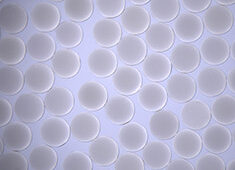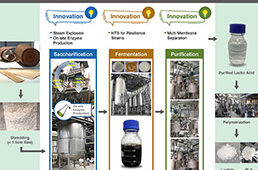Tilted-view scanning electron microscope (top) and cross-sectional transmission electron microscope (bottom) images of high-density bit-patterned media consisting of magnetic cobalt–palladium bits formed on hydrogen silsequioxane nanoposts defined by electron beam lithography. Image: 2011 IOP |
The
hard disk industry’s success to continuously drive recording densities
to new heights is owed to the use of granular media—nanoscopic magnetic
grains that are weakly coupled and randomly arranged on the disk
platters. Each individual bit of information is stored over an area
containing tens of grains.
There
are two common approaches to increasing the recording density of
granular media: one is to reduce the grain size and the other is to
reduce the number of grains per bit. Unfortunately, the general
consensus is that both approaches will have difficulty pushing beyond
the one terabit per square inch limit.
Joel
Yang at the A*STAR Institute of Materials Research and Engineering and
co-workers from the A*STAR Data Storage Institute and other institutions
have now come up with an alternative approach using so-called
bit-patterned media (BPM).
In
contrast to granular media, BPM consists of ordered arrays of
individual ‘superbits’ (see image) that are larger than the grains in
granular media and can be individually addressed on a disk platter to
improve signal-to-noise ratio. However, the fabrication of BPM requires
lithographic patterning, a costly process that necessitates substantive
viability studies to meet commercial requirements. Yang and his team
have now demonstrated the fabrication of BPM with densities as high as
3.3 terabits per square inch—or 15-nm pitch—using a method that does not
require pattern transfer processes such as etching and liftoff, which
typically reduce pattern fidelity.
The
new fabrication process involves only two steps. The first step
involves the use of electron-beam lithography on hydrogen silsesquioxane
resist to define silicon oxide nanoposts. “The resolution of our
technique is higher than most electron beam lithography processes
because we use a salt solution and development process that result in
closely-spaced nanopost-resist structures down to a 15 nanometer
density,” says Yang.
The
second step involves the deposition of cobalt–palladium films on top of
the nanoposts to forming isolated magnetic bits (see image). “Because
the nanopost resist is made of robust silicon oxide material, we can
avoid the etching step by depositing magnetic material directly onto
these nanostructures to form the magnetic bits,” explains Yang.
The
researchers used magnetic force microscopy (MFM) to analyze their BPM
and found that the magnetic bits are magnetically isolated, thus able to
store single bits of information, down to the best MFM-resolution of 20
nanometers. Yang and his team believe that the magnetic bits would
remain isolated and individually controllable up to 3.3 terabits per
square inch.
Fabrication and characterization of bit-patterned media beyond 1.5 Tbit/in2





